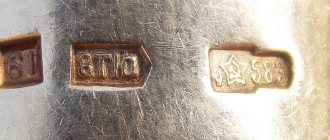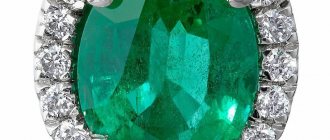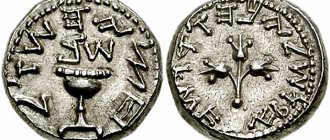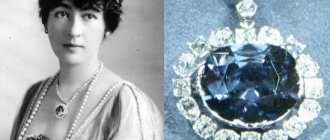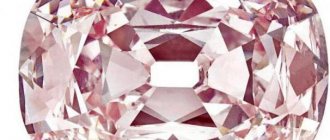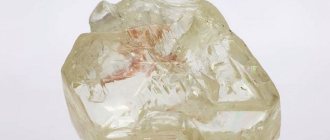The Great Mogul is a diamond with a short but bright life. This stone managed to awaken the basest passions around itself. In India they are still sure that the black soul of the demon of greed lived in Mughal. Perhaps someone will consider this opinion a prejudice, but the bloody history of the black diamond says otherwise.
The Great Mogul - a diamond with a short but bright life
Place of Birth
The place where the unprecedented black diamond was born has always been considered ominous and bringing death. But the diamond mines of Golconda until the 17th century were the source of the largest and most expensive stones. Adventurers and treasure hunters from all over the world flocked here in search of easy money. After the rainy season, streams of water flowing from the hills washed diamond placers into the light.
The dampness gave way to unbearable heat. The bed of the Krishna River turned into a thin, dirty stream flowing between the stones. Under the scorching sun, the hillsides emitted a ghostly glow. The season of seekers has begun - a period of merciless hunting for diamonds. Not everyone was able to come out of this fight alive: without water and shade, surrounded by poisonous snakes and cold-blooded rivals, it was a great success.
The hard work of diamond prospectors in the mid-17th century did not bring them fabulous incomes. The bulk of the stones found were sold at the market in the Golconda fortress. On the way from the mine to the reseller, the diamond could change several owners, becoming well saturated with their blood.
The first mention of a huge black diamond found in the Kolur mines, near Golconda, dates back to 1640. The whole story about him has almost no documentary evidence and, by and large, resembles a myth. Each narrator, to the delight of the listener, adds more and more details and his own vision to it.
However, a diamond of incredible size, almost 800 carats, was immediately noticed on the diamond market and confiscated by the authorities. It is also natural that the chroniclers name its first rightful owner as the Raja of Golconda, the main person in the city. But he did not even have time to enjoy the possession of the wonder: as soon as the Raja showed the stone to his family and retinue, his days were numbered. Some sources claim that the once devoted servant, succumbing to the evil spell of the stone, meanly killed his beloved master. Later, when he came to his senses, he realized what he had done. To avoid inevitable death, he secretly brought the stone to Agra, where he presented it as a gift to Shah Jahan, the great padishah and ruler of the world.
We also recommend reading:
The history and curse of the Kohinoor stone The marvelous ametrine stone Characteristics of larimar and its main properties Selection of stones by date of birth
Fall of the Mongol Empire
The main residence of the Great Mughals was the city of Delhi, which was once the center of the Delhi Sultanate. Until the beginning of the eighteenth century, the shahs still managed to rule the state from here. But gradually the provinces began to declare their independence and resolving issues from Delhi became increasingly difficult.
By the fortieth year of the eighteenth century, the empire had lost part of its territories due to separatist sentiments. Seeing the weakening of the state, Persians and Afghans began to raid its borders. Their armies devastated vast territories, the population of which was enslaved.
Gradually, the British began to interfere in imperial affairs. The fight against them was not crowned with victory for the Shahs. As a result, they had to agree to cooperate and let the British into their lands. All this happened against the backdrop of struggle between the Muslim and Hindu communities. The former power of the empire was rapidly melting away.
In the fifty-eighth year of the nineteenth century, British troops entered Delhi under the pretext of suppressing a rebellion against their presence in India. This became the last day of the capital of the Mughals and their empire.
New crystal name
Mughal the Great Shah Jahan - a new name, the padishah was so shocked by the greatness of the black diamond that he gave it one of his many names.
This is how the story of the diamond, the Great Mogul, was born. There is no need to say that each name brings a certain energy to its owner. To understand what the name “Mughal” meant at that time, you will have to delve a little into the history of Shah Jahan. It truly evoked mystical awe among contemporaries. All the negative human qualities that have ever existed, magnified many times over and mixed with incredible vanity, were combined in him. His path to power is strewn with corpses: family members, children, relatives, entire nations. The great padishah had nothing sacred except strengthening his power. Only once did he experience love for one of his six wives - Mumtaz Mahal. But when she died during childbirth, the rage of the ruler of the world returned to him with renewed vigor.
A few words about the Mongol Empire
The Mughal Empire was formed around the first quarter of the sixteenth century and lasted until the eighteenth century. The state was the legacy of the Timurids and was formed on the fragments of the Delhi Sultanate. Surprisingly, throughout its existence the empire had very blurred borders. At the same time, they were constantly changing, so today scientists can very roughly name the territories occupied by the Great Mughals.
Historians claim that the empire extended across the lands of such modern states as India, Pakistan, Bangladesh and parts of Afghanistan. This alone gives an idea of how vast the empire created by the fugitive heir of Genghis Khan and Tamerlane was. This boy is considered the founder of the Great Mughals, therefore the entire ruling dynasty is often called the Baburids after his name.
I would like to note that the Mughals themselves never called themselves this word. It was first used by the British, who considered all Muslims living in India to be Mughals. The name quickly stuck, and Babur’s people entered history precisely as the Great Mughals.
But to be historically accurate, the state was founded by different tribes of Central Asia. Led by Babur, representatives of Turkic, Mongolian and other nationalities entered the territory of modern India and managed to stay there for several centuries.
I would also like to mention one feature of the ruling Mughal dynasty. Its representatives were fluent in two languages. They spoke fluently in Turkic and Persian, which indicates a reverent attitude towards their roots.
Gallery: Great Mogul diamond (50 photos)
Having received such an incredible diamond as a gift, Shah Jahan officially became the owner of the largest treasure in the world. The padishah idolized this stone so much that in terms of beauty and splendor he compared it only with his own imperial person.
Hortensio Borgis, one of the best jewelers of that time, was invited from Venice to process the stone. It is difficult to imagine with what horror the Italian master began to work. However, after his work, only 280 carats remained of the impressively sized diamond. Moreover, the incorrect shape of the cut revealed flaws - a crack in the lower part and a slight clouding inside the stone.
The emperor's anger knew no bounds. It is impossible to imagine that a bloody tyrant, who did not know what forgiveness was, let the unfortunate jeweler go alive. And although some chroniclers claim that the master was kicked out, taking away an impressive advance, others are sure that he was executed, which is also very possible: Shah Jahan could hardly endure such a blow to his pride. Thus, the cursed stone chalked up another victim.
Over the course of his life, more than 20 children were born to the Great Padishah. Not all of them lived to adulthood and followed in their father's footsteps. Aurangzeb was the son on whom Shah Jahan had the highest hopes. But the emperor’s mistake was that without giving love and teaching trust, he hoped to receive it from his children. In 1658, Aurangzeb, with the help of vile intrigues, started a war between the possible heirs to the throne. Left out of competition, he overthrew his parent. The padishah spent the last 8 years of his life in captivity in one of the fortresses, which he built to confirm his power. The throne, along with the diamond - the Great Mogul, passed to the new owner.
The black diamond has survived another owner. In 1655, a year before his father’s death, Aurangzeb demonstrated the symbol of his power to the European traveler and diamond hunter Jean Baptiste Tavernier. Until now, the documentary records of the enterprising Frenchman are the only direct evidence of the existence of the Great Mogul.
Shocked by the depth and mystical magnetism of the stone, the merchant asked permission to describe the treasure in order to tell the whole world about its existence. Is it worth saying how much this request flattered the new padishah? With the pedantry characteristic of merchants, Tavernier made detailed sketches and described all the stories associated with the black diamond at that time.
According to him, the processed Mughal nugget was 280 carats in size and cut in the form of an irregularly shaped rose elongated from a hemisphere. The color is black, with a strange blue glow from within, as if attracting the eye. Throughout his life, Tavernier could not forget what he felt next to this stone. Returning to Paris, he married the daughter of a wealthy jeweler and devoted the rest of his life to memoirs.
Titles of the ruling dynasty
It is known that the Mughal Empire possessed untold wealth. Its rulers built buildings of extraordinary beauty, and the interior decoration of the palaces had no equal in luxury in the world. It is quite natural that the representatives of the ruling dynasty had several titles. All of them created a certain ornate image, giving the ruler majesty and symbolizing his special status.
The very first and most significant title, adopted by Babur, sounds like padishah of the Great Mughals (questions are often asked on this topic in scanwords). This is exactly what Europeans talk about the rulers of the empire, but the original version of the title sounds a little different - Padshah-i-Ghazi. If we translate, we can say that the representatives of the ruling dynasty called themselves as follows - sovereign, ruler of kings and warrior of Islam. However, this is not the full title of the Great Mughals.
To the already known Padshah-i-Ghazi was added the ornate set of words “Shahanshah-i-Sultanate-ul-Hindia-wa-l-Mughaliya”. In the West, there were several versions of its translation. But most often this title sounded like “king of kings of Mongol India.”
In addition to the titles already listed, each ruler added his own, characterizing him from the best side. Among them, the most famous are the following:
- al-Sultan al-Azam - great sultan;
- al-Hakan al-Mukarram - revered kagan;
- Amir al-Mu'minin - Commander of the Faithful;
- Zillullah is the shadow of Allah;
- Abul Fatah - the father of victories;
- Jalal ad-din - greatness of faith;
- Abul Muzaffar - victorious;
- Malik-ul-Sultanate is the king of kings.
This is not a complete list of titles of the rulers of the empire. The padishah of the Great Mughals (scanword puzzles often baffle even recognized history experts with such questions) bore several titles at the same time. Sometimes they took up two or even three lines in the document.
Blood trail
Aurngzeb, as the new ruler and owner of the Great Mogul, also did not revel in power for long. His fate was much sadder than that of his father. After his death, for 30 years, power in India and the cursed stone passed from hand to hand, becoming covered with an ever-increasing layer of blood from the previous owners. The internecine wars completely weakened the empire, bringing its economy into complete decline. India plunged into hunger and poverty, and those in power were mired in corruption. And only the diamond trade slightly kept the empire afloat.
Taking advantage of this, the Persian ruler Nadir Shah attacked India in the winter of 1739. It is very difficult to call what happened a war. Nadir Shah led his troops to Delhi, showing everyone his fighting power. The ruling Indian padishah surrendered without a fight and himself brought the keys to the city to the attacker. Among the captured treasures, the Mogul stone also fell into the hands of Nadir Shah. The Hindus hoped in vain for the mercy of the attackers. For a whole month they were plundered and robbed, and there was no number of people killed.
The Great Akbar - the true founder of the Mongol Empire
Babur's grandson was born during a period of constant military campaigns. The boy's childhood was spent moving, which left a serious imprint on his character and upbringing. Akbar showed great inclination towards military affairs. He skillfully handled the gun and showed himself to be an excellent strategist. By the age of twelve, the boy was already a skilled warrior and became a full participant in the campaign against India.
It turned out to be very successful for the Mughals, and power returned to their hands. However, Humayun did not enjoy his triumph for long - approximately two years later he fell from a steep staircase and died as a result of a severe skull injury. Fourteen-year-old Akbar ascended the throne, becoming a great ruler in the future.
Humayun's son ruled for almost half a century and created a great empire where all peoples coexisted peacefully and the provinces prospered. Historians believe that Akbar’s most important goal was to unite the lands and achieve peace in the annexed territories. The cessation of the existence of Muslim states is considered a great achievement of his policy. All of them gradually became part of the empire. Akbar tried to act by persuasion, but if necessary, he also used force. He also dealt with the Indian Rajahs, who soon became loyal vassals of the Great Mogul.
Akbar paid great attention to culture. He had great respect for other people's traditions and religion. This was especially true for the cultural heritage of the Hindus. The ruler ordered their sacred texts to be translated into Persian. Despite the differences between religious beliefs in the country, the ruler managed to maintain peace between faiths. He did not forbid them to perform their rituals, with the exception of those that were accompanied by cruelty and human sacrifices.
In order to completely eliminate religious conflicts in the empire, Akbar spent a lot of time creating a new religion based on five beliefs. During the life of the Great Mogul, it was almost completely formed and introduced at the official level.
How to distinguish a real diamond from a fake one (video)
In 1747, Nadir Shah suffered a mysterious death. And the black rose did not bring him happiness. Since then, the Persian chronicles have been cleaned up of unnecessary details, and the history of the cursed stone was not mentioned anywhere else, it simply disappeared. The story is about a strange and very mysterious treasure that no one could buy, sell or simply hold in their hands. People, dynasties and states paid with their lives for its possession. And no one could resist this terrible beauty. I would like to believe that the Mogul crystal stopped and completed its mission.
Aurangzeb's successors
Until the twenties of the eighteenth century, the empire was moving by leaps and bounds towards its collapse. None of the rulers had sufficient strength and support from their subjects to retain power in their hands for a long time. Everyone ascended to the throne thanks to military leaders and, if necessary, were overthrown by them overnight. All of them were just puppets in capable hands. But due to its wealth, the empire still maintained the appearance of prosperity.
Colorless diamond “Cullinan” - 3106 carats (621.35 g)
The gemstone got its name from the owner of the Premier mine, Thomas Kulian, where it was accidentally found while mining rocks in 1905 in the English Transvaal, located in southern Africa. The fist-sized diamond struck me with its amazing clarity. There were no foreign mineral formations in it, there were no bubbles or cracks. "Cullian." It was valued by experts at $7.5 billion. 2 years after the discovery, this unique diamond was given to the British King Edward VII by the Transvaal government.
During the processing process, the stone had to be split into 2 parts. The largest piece produced a colorless pear-shaped diamond with 74 facets weighing 530.2 carats, which was named Cullinan I or Star of Africa. Today it decorates the top of the royal scepter of Great Britain and is valued at $400 million. Another fragment of the Little Star of Africa (Cullinan II) diamond was cut into an emerald shape and now weighs 317.4 carats. In total, 4 large and 96 small diamonds were made from the Kullian diamond.
Colorless diamond “Millennium Star” weight - 777 carats (155.4 g)
The colorless gemstone, which after cutting received the name “Star of the Millennium,” was found in 1990 in Mbuji-Mayi (formerly Zaire). After three years of cutting using the latest laser technologies, which took place in stages in Belgium, South Africa and then in the USA, it weighed 203.04 carats and acquired a pear-shaped shape with 54 facets. This beautiful diamond was included in the Millennium collection of precious stones from the famous diamond company. It was officially presented in New York in 1999, and a year later they tried to steal the stone, but the attempt failed. It is known that the diamond was insured for £100 million.
Yellow-brown diamond “Incomparable” - weight 890 carats (178 g)
The yellow-brown gemstone was found by a girl in a pile of waste from diamond mines in 1980 in the city of Mbuji-Mayi in Zaire. In the process of cutting the diamond, the “Incomparable” diamond was born with an exquisite triangular shape (triolet), its weight was 407.48 carats. In 1988, "Incomparable" was sold at Christie's for $12 million, and was subsequently resold in 2002 at an electronic auction for $15 million . The unique gem was seen in 2009 by visitors to the Royal Canadian Museum in Ontario. 4 years later, this stunningly beautiful diamond became the decoration of a rose gold necklace inlaid with 91 diamonds.
Botswana diamond, weight - 1111 carats (222 g)
This large white diamond is the largest in the last 100 years, the size of a tennis ball . It was mined in 2015 at the Karowe mine, located in South Africa on the border of the Kalahari and Karoo deserts. The precious crystal has a unique purity and transparency that meets all international standards. For its high quality it is classified into the highest category 2a. This stone is ideal for making fine jewelry. According to preliminary estimates, its cost reaches 100 million euros.
River Woye diamond weighing 770 carats (154 g)
The second name of this diamond is “Victory Diamond”. It was discovered near the Woye River in Sierra Leone, near Sefadu on January 6, 1945, so it was also named in honor of the year of Victory over Nazi Germany. The gemstone had a diamond shape. 30 diamonds were made from the diamond. The largest of them weighed 31.35 carats. No one knows what these diamonds look like, since their owners do not prefer to reveal them to the public.


